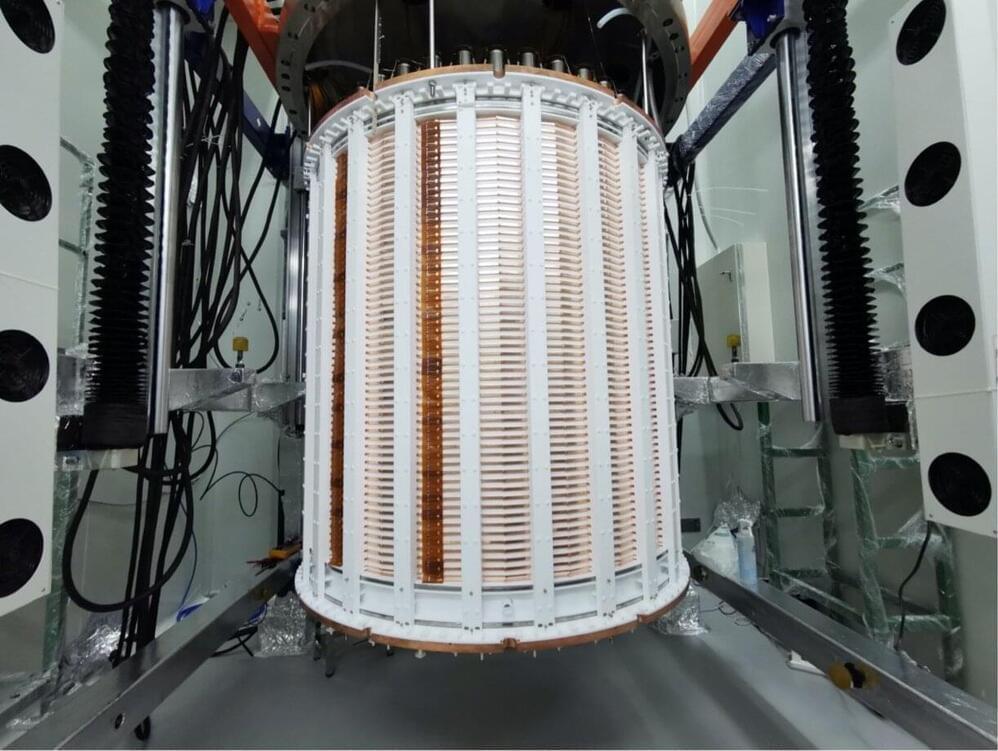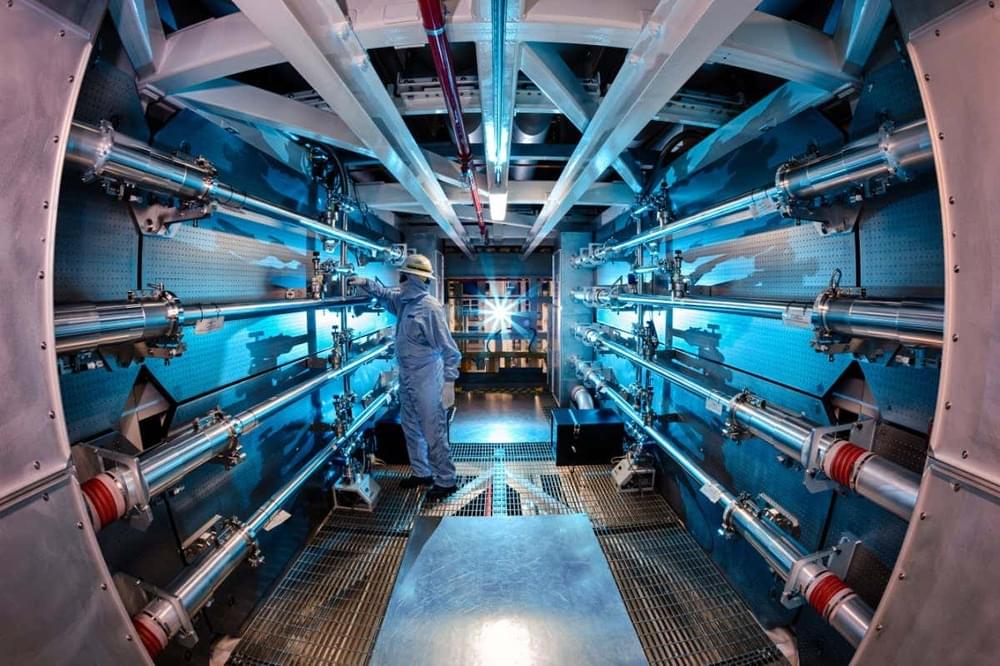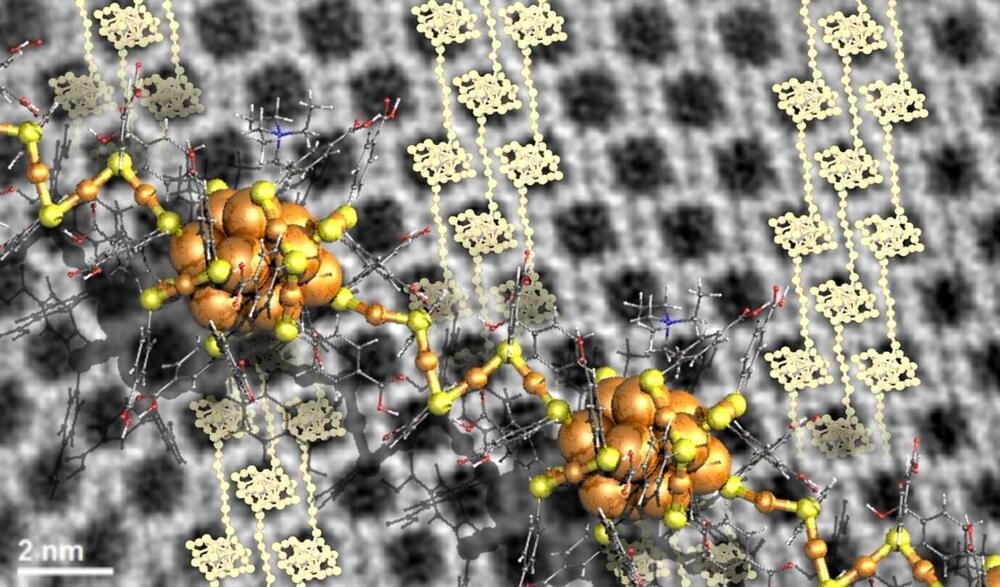A new particle accelerator has just begun operation. It is the most powerful accelerator of its kind on Earth and will allow physicists to study some of the rarest matter in the universe.
Category: particle physics – Page 386

Recent searches for light fermionic dark matter by the PandaX-4T collaboration
Teams of astrophysicists worldwide are trying to observe different possible types of dark matter (DM), hypothetical matter in the universe that does not emit, absorb or reflect light and would thus be very difficult to detect. Fermionic DM, however, which would be made of fermions, has so far been primarily explored theoretically.
The PandaX Collaboration, a large consortium of researchers in China involved in the PandaX-4T experiment, has recently carried out a study aimed at extending the sensitive mass window for experiments aimed at directly detecting fermionic DM from above GeV to MeV or even keV ranges.
The team recently published two papers in Physical Review Letters outlining the results of the two searches for the absorption of fermionic DM using data gathered as part of the Panda X-4T experiment, a large-scale research effort aimed at detecting DM using a dual-phase time projection chamber (TPC) in China.

Is Physical Law an Alien Intelligence?
Perhaps Arthur C. Clarke was being uncharacteristically unambitious. He once pointed out that any sufficiently advanced technology is going to be indistinguishable from magic. If you dropped in on a bunch of Paleolithic farmers with your iPhone and a pair of sneakers, you’d undoubtedly seem pretty magical. But the contrast is only middling: The farmers would still recognize you as basically like them, and before long they’d be taking selfies. But what if life has moved so far on that it doesn’t just appear magical, but appears like physics?
After all, if the cosmos holds other life, and if some of that life has evolved beyond our own waypoints of complexity and technology, we should be considering some very extreme possibilities. Today’s futurists and believers in a machine “singularity” predict that life and its technological baggage might end up so beyond our ken that we wouldn’t even realize we were staring at it. That’s quite a claim, yet it would neatly explain why we have yet to see advanced intelligence in the cosmos around us, despite the sheer number of planets it could have arisen on—the so-called Fermi Paradox.
For example, if machines continue to grow exponentially in speed and sophistication, they will one day be able to decode the staggering complexity of the living world, from its atoms and molecules all the way up to entire planetary biomes. Presumably life doesn’t have to be made of atoms and molecules, but could be assembled from any set of building blocks with the requisite complexity. If so, a civilization could then transcribe itself and its entire physical realm into new forms. Indeed, perhaps our universe is one of the new forms into which some other civilization transcribed its world.

Nuclear fusion reactions create unexpectedly high-energy particles
Burning plasma fusion reactions, thought to be crucial for building working fusion reactors, are producing more high-energy particles than researchers expected. Solving the mystery of why could be key to making fusion viable.

Scientists Discover The “Angel Particle” Which Is Both Matter And Antimatter At The Same Time
Scientists have discovered proof of a strange particle that strangely enough is also its own antiparticle. Even though it was initially postulated 80 years ago, it now seems that it just could be true.
Scientists from the University of California and Stanford University in California performed the research that was published in the journal Science. A particle might have its own antiparticle, according to a notion initially put out in 1937 by Italian scientist Ettore Majorana (who suddenly vanished in 1938). According to him, certain particles in the fermion class, which includes protons, electrons, and neutrons, ought to have unique antiparticles. These particles later came to be known as Majorana particles.
A particle with the same mass as a normal particle but the opposite electric or magnetic properties is said to be an antiparticle. The positron, for instance, is the antiparticle of the electron. If the two come into contact, they destroy one another.


Research team creates a superfluid in a record-high magnetic field
Circa 2015 face_with_colon_three
MIT physicists have created a superfluid gas, the so-called Bose-Einstein condensate, for the first time in an extremely high magnetic field. The magnetic field is a synthetic magnetic field, generated using laser beams, and is 100 times stronger than that of the world’s strongest magnets. Within this magnetic field, the researchers could keep a gas superfluid for a tenth of a second—just long enough for the team to observe it. The researchers report their results this week in the journal Nature Physics.
A superfluid is a phase of matter that only certain liquids or gases can assume, if they are cooled to extremely low temperatures. At temperatures approaching absolute zero, atoms cease their individual, energetic trajectories, and start to move collectively as one wave.
Superfluids are thought to flow endlessly, without losing energy, similar to electrons in a superconductor. Observing the behavior of superfluids therefore may help scientists improve the quality of superconducting magnets and sensors, and develop energy-efficient methods for transporting electricity.

Researchers learn to engineer growth of crystalline materials consisting of nanometer-size gold clusters
First insights into engineering crystal growth by atomically precise metal nanoclusters have been achieved in a study performed by researchers in Singapore, Saudi Arabia and Finland. The work was published in Nature Chemistry.
Ordinary solid matter consists of atoms organized in a crystal lattice. The chemical character of the atoms and lattice symmetry define the properties of the matter, for instance, whether it is a metal, a semiconductor or and electric insulator. The lattice symmetry may be changed by ambient conditions such as temperature or high pressure, which can induce structural transitions and transform even an electric insulator to an electric conductor, that is, a metal.
Larger identical entities such as nanoparticles or atomically precise metal nanoclusters can also organize into a crystal lattice, to form so called meta-materials. However, information on how to engineer the growth of such materials from their building blocks has been scarce since the crystal growth is a typical self-assembling process.

Don’t Let Yourself Get Tangled Up
Quantum mechanics, the theory which rules the microworld of atoms and particles, certainly has the X factor.
Unlike many other areas of physics, it is bizarre and counter-intuitive, which makes it dazzling and intriguing.
When the 2022 Nobel prize in physics was awarded to Alain Aspect, John Clauser, and Anton Zeilinger for research shedding light on quantum mechanics, it sparked excitement and discussion.

‘Spooky action at a distance’ can lead to a multiverse. Here’s how
Some interpretations of quantum mechanics propose that our entire universe is described by a single universal wave function that constantly splits and multiplies, producing a new reality for every possible quantum interaction. That’s quite a bold statement. So how do we get there?
One of the earliest realizations in the history of quantum mechanics is that matter has a wave-like property. The first to propose this was French physicist Louis de Broglie, who argued that every subatomic particle has a wave associated with it, just like light can behave like both a particle and a wave.